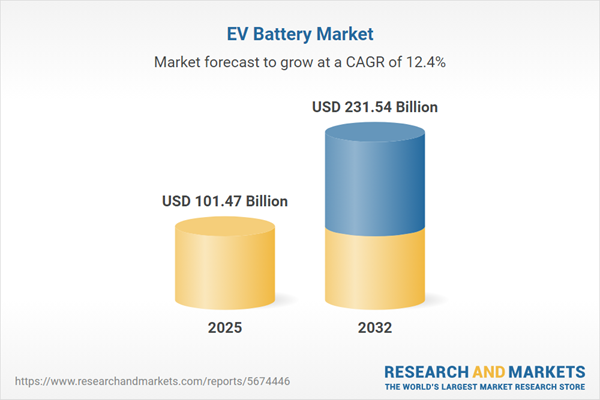Speak directly to the analyst to clarify any post sales queries you may have.
The electric vehicle battery market is seeing critical advancements that are redefining the future of the automotive and energy sectors. Senior leaders will find this report a comprehensive resource for understanding evolving supply chains, emerging battery technologies, and strategic shifts impacting global competitiveness.
Market Snapshot: EV Battery Market Size & Outlook
The EV battery market grew from USD 90.75 billion in 2024 to USD 101.47 billion in 2025. It is projected to continue expanding at a robust CAGR of 12.42%, reaching USD 231.54 billion by 2032. Surging demand for higher energy density, safety enhancements, and sustainability are driving ongoing technology investments and strategic realignments across manufacturing and supply chains. Evolving regulatory regimes, digital integration, and global policy shifts all influence the trajectory of this dynamic sector.
Scope & Segmentation: Comprehensive Market Coverage
This report delivers deep analysis across the electric vehicle battery ecosystem, delineating major segments and technological domains critical for business strategy. The EV battery market is segmented and examined by the following factors:
- Battery Type: Lead Acid Batteries, Lithium-Ion Batteries, Nickel-Metal Hydride Batteries, Solid-State Batteries
- Charging Capacity: 40-90 kWh, Above 90 kWh, Below 40 kWh
- Battery Form: Cylindrical, Pouch, Prismatic
- Propulsion Type: Battery Electric Vehicle, Fuel Cell Electric Vehicle, Hybrid Electric Vehicle, Plug-In Hybrid Electric Vehicle
- Vehicle Type: Commercial Vehicles - Heavy Commercial and Light Commercial; Passenger Vehicles - Hatchbacks, Sedans, SUVs
- Distribution Channel: Offline, Online
- Regional Focus: Americas (United States, Canada, Mexico, Brazil, Argentina, Chile, Colombia, Peru), Europe, Middle East & Africa (United Kingdom, Germany, France, Russia, Italy, Spain, Netherlands, Sweden, Poland, Switzerland, United Arab Emirates, Saudi Arabia, Qatar, Turkey, Israel, South Africa, Nigeria, Egypt, Kenya), Asia-Pacific (China, India, Japan, Australia, South Korea, Indonesia, Thailand, Malaysia, Singapore, Taiwan)
- Key Companies: AESC Group Ltd., BYD Co. Ltd, Amara Raja Batteries Limited, Clarios LLC, Contemporary Amperex Technology Co. Limited, Exicom Tele-Systems Limited, Exide Industries Ltd., Farasis Energy Europe GmbH, GS Yuasa Corporation, Hero MotoCorp Ltd, Hitachi Ltd., Johnson Controls Inc., LG Energy Solution, Ltd., Mitsubishi Corporation, Northvolt AB, Okaya Power Pvt. Ltd., Panasonic Corporation, SAMSUNG SDI Co., Ltd., Tata Motors Limited, Tesla, Inc., Tianjin Lishen Battery Joint-Stock Co., Ltd., Tianneng Power International Limited, Toshiba Corporation
Key Takeaways: Strategic Insights for Market Leaders
- The convergence of digital manufacturing, advanced chemistry R&D, and vertical integration is crucial for optimizing cost structures and ensuring consistent quality in the EV battery market.
- Regional differences in policy, infrastructure, and raw material access are compelling manufacturers to develop tailored approaches for supply chain localization and resource security.
- Rising sustainability mandates are accelerating adoption of eco-friendly production methods and incentivizing circular economy practices, including recycling and second-life battery applications.
- Increasing collaboration between OEMs, technology providers, and raw material suppliers is expediting the commercial deployment of next-generation battery architectures and forms.
- Diversified procurement strategies, strategic partnerships, and ecosystem integration are emerging as key responses to market volatility and competitive pressure in the sector.
Tariff Impact: Shaping Global Battery Supply and Investment
Recent tariffs introduced by the United States present new cost challenges for battery components and raw materials sourced internationally. Manufacturers are intensifying efforts to localize production, diversify sourcing, and invest in regional facilities to maintain stable supply and manage cost pressures. These developments are prompting new investment hotspots and regional supply realignments as firms strategize around policy incentives and exemptions.
Methodology & Data Sources
This analysis utilizes a mixed-method approach, merging primary interviews with industry leaders, suppliers, and integrators with rigorous secondary research. Data validation leverages technical journals, industry whitepapers, and operational case studies. Comparative benchmarking and scenario analysis underpin the strategic recommendations, ensuring the accuracy and relevance of market insights.
Why This Report Matters
- Offers actionable intelligence to align supply chain, procurement, and investment decisions with shifting policy and technology trends.
- Equips senior decision-makers to anticipate and navigate regulatory, geopolitical, and technological disruptions in the EV battery landscape.
Conclusion
This report empowers stakeholders with the insights required to drive innovation, enhance market readiness, and seize opportunities as the electric vehicle battery sector transforms. Strategic planning rooted in this analysis will support leadership in attaining both growth and resilience objectives.
Additional Product Information:
- Purchase of this report includes 1 year online access with quarterly updates.
- This report can be updated on request. Please contact our Customer Experience team using the Ask a Question widget on our website.
Table of Contents
3. Executive Summary
4. Market Overview
7. Cumulative Impact of Artificial Intelligence 2025
Companies Mentioned
The companies profiled in this EV Battery market report include:- AESC Group Ltd.
- BYD Co. Ltd
- Amara Raja Batteries Limited
- Clarios LLC
- Contemporary Amperex Technology Co. Limited
- Exicom Tele-Systems Limited
- Exide Industries Ltd.
- Farasis Energy Europe GmbH
- GS Yuasa Corporation
- Hero MotoCorp Ltd
- Hitachi Ltd.
- Johnson Controls Inc.
- LG Energy Solution, Ltd.
- Mitsubishi Corporation
- Northvolt AB
- Okaya Power Pvt. Ltd.
- Panasonic Corporation
- SAMSUNG SDI Co., Ltd.
- Tata Motors Limited
- Tesla, Inc.
- Tianjin Lishen Battery Joint-Stock Co., Ltd.
- Tianneng Power International Limited
- Toshiba Corporation
Table Information
| Report Attribute | Details |
|---|---|
| No. of Pages | 182 |
| Published | November 2025 |
| Forecast Period | 2025 - 2032 |
| Estimated Market Value ( USD | $ 101.47 Billion |
| Forecasted Market Value ( USD | $ 231.54 Billion |
| Compound Annual Growth Rate | 12.4% |
| Regions Covered | Global |
| No. of Companies Mentioned | 24 |









